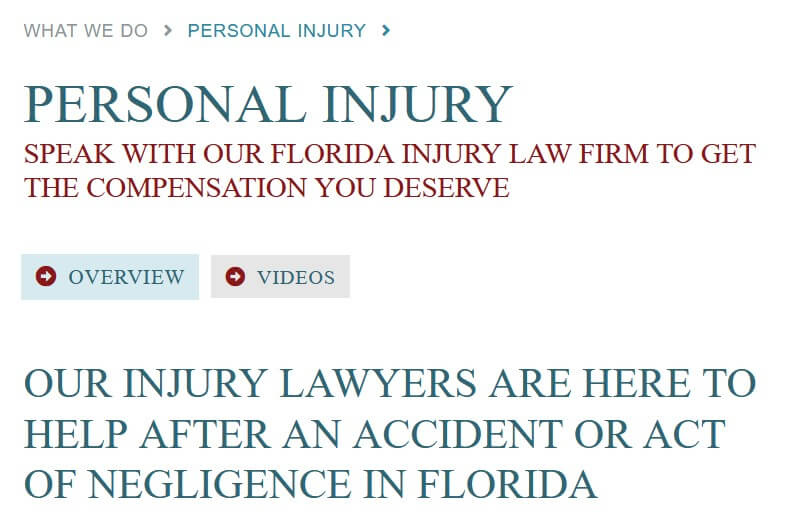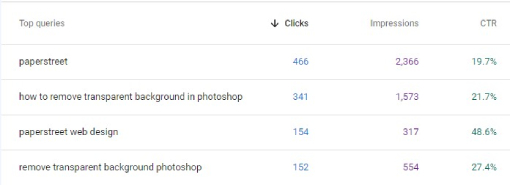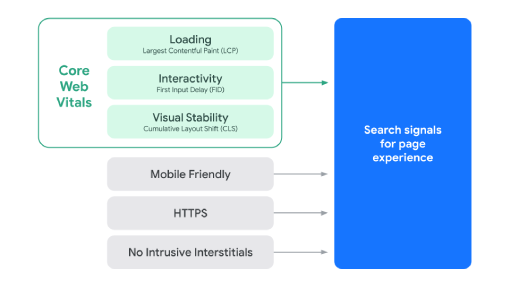SEO Glossary for Lawyers (10 Must Know Phrases)

If you are in the legal industry and are exploring SEO techniques for your firm, you may have come across some unfamiliar phrases. In this post, we discuss the 10 “must-know” phrases before you get started so you will be better versed in the subject matter. Each glossary item below can be its own blog post, but we will cover the basics of what you need to know.
Keyword Research
This is one of the first steps to be performed for an SEO campaign. It starts by defining the geographic areas you want to target (international, national, state or city), the types of services you provide (your practice areas) and then multiplying it by legal base terms (attorney, law firm, lawyer).
After multiplying these terms together, you will come up with a large list of potential keywords to target. Then, these keywords are fed into a keyword research tool where you can see the actual data regarding these keywords.
The research tools will notate on average how often a certain keyword is searched monthly along with a difficulty score. The difficulty score uses the websites that currently rank for the keyword and how difficult it will be to outrank the competition.
Based on the data and what is most popular, you can make decisions on what you want to target and be relevant for. The goal would be to monitor your rankings for a targeted keyword and see an upward progression that eventually leads you to being on the first page and hopefully within the top 3 organic results.

On-page Optimization
Once your targeted keywords have been established, the website needs to be optimized accordingly for the keywords. This helps signal to Google the keywords that you want your website and pages to be relevant for and rank for those searches accordingly.
Applying on-page optimization encompasses adjusting your title tag, meta description, page headlines, body content, page URL, and images accordingly to be relevant and encompass the keywords. However, you want the changes to sound natural when possible and not go overboard injecting these areas with too many keywords known as over-optimization or keyword stuffing.
Also, you want each page to be optimized for a single subject matter and its synonyms. Typically, the home page will account for your overarching keyword that defines your law firm. For example, if you are a personal injury firm, the home page tends to rank for the keyword the describes your practice in full. Then subpages are optimized for the facets that fall under personal injury like car, truck, and motorcycle accidents.

White/Gray/Black Hat Tactics
This terminology refers to the different approaches businesses and agencies take when trying to do search marketing with SEO. There are specific guidelines that are supposed to be followed for your marketing campaign and the standards of quality are set by Google.
Since SEO is more of an art then a science, there are many different approaches that can help get you results. However, some tactics provide a short-term boost and then may later be penalized by Google for the inappropriate actions.
White hat tactics refer to a purist approach to SEO where all rules and regulations are followed exactly by what is set by Google and other search engines.
Gray hat tactics refer to abiding by most of the rules but trying some experimental strategies that push the borders of what is allowed. This can entail tactics like targeting expired domains that are high authority and then redirecting them back to your website or creating a private blog network which is a group of websites that you control which are used to build backlinks (more on this below) to a single website.
Black hat tactics refer to never following any of the guidelines that are set forth by Google. This can result in a possible short-term gain but can eventually harm your marketing efforts in the long run due to penalization. These strategies include doorway pages that are solely intended for ranking purposes and not a part of your site structure, hidden text or links on a page or article spinning where someone else’s content is copied but the words are slightly altered.
At PaperStreet, we are proud to say that we only follow the white hat methodology.

Competitor Analysis
When diving into SEO you will want to review your competitors to see who you are up against. This mainly involves reviewing what type of content they have posted on their website, how in-depth it goes, how well researched it is, how frequently they are blogging and keeping their content fresh to get an understanding of their overall content strategy.
A competitor analysis would also involve using tools (like Ahrefs) to see what type of backlinks a competitor website is receiving and understanding what efforts it took to achieve. Meaning, was your competitor featured in a lot of magazine or news stories? Are they signed up in certain legal directories that you are not listed in? Keeping up and then surpassing you competition is always a good strategy to take.
Lastly, its helpful to review your competitor’s presence on social media (including YouTube) and even paid advertising networks like Google Ads. There are tools available to help you “spy” on your competitors. It can help you to see the efforts they put forth posting on social media and engaging their audience along with how many reviews they are receiving. Also, it’s helps to have an estimate of how much a competitor may be spending on advertising space and where they are targeting.

Crawling & Indexing
This refers to how Google and other search engines discover your web pages and have it appear in their search engine results. If you produce content, no one will be able to find it in search engines until it has been crawled by Google and evaluated from a quality standpoint. If it is up to Google’s standards and they see it as a valuable contribution to the internet, they will choose to add it to their massive index of web pages and rank it appropriately for relevant search queries.
You need to make sure from a technical perspective that you are not blocking access to these pages or sending accidental signals to Google that you do not want these pages to be crawled or indexed. It is also helpful to create an XML sitemap which is a digital file that lists all the pages you want Google to discover on your website. This helps speed up the discovery process for Google and other search engines to crawl your content and hopefully index it.

Backlink
This refers to a third-party website that contains a link leading back to your website. It can be from a news publication or simply a legal directory.
In the eyes of Google and other search engines, they see this is a “friend vouching for a friend” and helps to strengthen your website’s authority. Typically, the more backlinks a website has the more powerful it will be in search rankings and will have a better chance of appearing more often for highly competitive keywords.
The type of website that is linking to you also matters. For example, if the website has no relevancy to your industry, it will make less of an impact, but the opposite exists as well. Getting a backlink from a very powerful website (like CNN) will have a much larger impact on your SEO presence. Back in the 90’s getting backlinks used to be about quantity over quality but now it is completely the opposite. It is still good to have a high quantity of backlinks, but the quality also matters even more.
Click-Through Rate
Have you ever wondered how many times your webpage appeared in search results vs. how many times it was clicked? If so, that is the definition of your click-through rate.
If you are using Google Search Console and Bing Webmaster Tools, which are a free online applications for Webmasters to communicate with Google and Bing, this data can be provided to you and is quite helpful to know where opportunities exist to improve.
Google and Bing will show you how often a certain page appeared in the search results for a given keyword vs. how often it was clicked. If you have a page that is ranked well, has a high number of impressions but a low click-through rate, that means that people are not being enticed to click on your listing for some reason.
Since your title tag and meta description is what is shown on your listing, it would be best to experiment and tweak the language to see if that helps improve your click-through rate. Also, think about if the page qualifies for any rich snippet opportunities which will also help your page standout.

Website Conversion
This refers to the action a visitor takes on your website that would be the equivalent of “making a sale” or “generating a lead” for your business.
However, a conversion is unique to each website and what they are trying to accomplish. In the legal industry, websites have their contact information listed along with a contact form. When a visitors session ends in contacting the website through either phone or contact form that would be considered a successful visit that converted.
This is typically tracked using Google Analytics (which will be discussed below) or a call tracking service that dynamically swaps your business number to a tracking number and any calls made to that number are recorded data.
Lastly, there can also be “micro conversions” which are steps a visitor might take before actually converting. That can either be watching a video about the firm, signing up for a newsletter, viewing a certain number of pages on the website or staying for a length of time. These actions hopefully result in a full fledge conversion eventually but may take a repeat visit from the user to accomplish the action.

Page Experience & Core Web Vitals
This refers to algorithm updates that Google has made over the last few years that aim to reward sites that favor the user’s experience and penalize those that do not.
The first iterations of page experience encompassed three signals. The first was having an SSL certificate applied to your website and having it be more secure. The second is having a mobile-friendly website that is optimized for viewing on a mobile device. Meaning, the website collapses accordingly from a desktop view so that the website is also easy to use on mobile. The third is not having any intrusive pop-ups that cover the whole screen and make it difficult for a visitor to view your content and interact with your website.
These algorithm updates now also encompass what is called Core Web Vitals. These are three metrics that are associated with how the website loads for the visitor. You need to pass the benchmarks set by Google on how fast the largest element of your webpage loads, how long the delay is to interact with anything on the site (like a form) and the visual stability of the website when it is loading in and making sure elements on the page do not shift around.

Google Analytics
Google Analytics is a free web analytics service that will gather data related to how visitors interact with your website. This is a must-have for all search marketers who are running SEO campaigns.
It is a very robust tool that can help show you if your website is having successful interactions with your visitors and where improvement opportunities exist. Google Analytics is broken down into 4 main sections: audience, acquisition, behavior, and conversions.
Audience
The section shows data related to all the details of your visitors. This includes data related to their demographics, location, language, new/returning visitor, technology used to view the website and if they were using a mobile or desktop device.
Acquisition
The section shows data related to how visitors found your website. This section will show you a breakdown of the different mediums that are producing traffic to your website. It will categorize your traffic into channels like direct, organic, referral, paid and social. This way if you are running any kind of marketing campaign you can measure the effectiveness of it.
Behavior
The section shows data related to what content your visitors interact with once they are viewing your website. It will show what pages are driving traffic into the website along with what pages are viewed once a visitor is interacting with your website. This demonstrates what content on your website is popular and vice versa. There’s also data captured related to how long a visitor interacts with a certain page and if they view any pages afterwards.
Conversions
Lastly, the section shows data related to any defined goals that you have setup. These do not come setup by default with but are easily implemented. A common conversion goal would be a contact form submission. Google Analytics can record whenever a visitor lands on a confirmation/thank you page from your form submission and denotes that a converting visit. Then you can attribute those conversions to channels to show what is proving to be most successful and what needs improvement.

Questions or Feedback?
We would love to hear your feedback if this blog post has helped you. Please feel free to let us know in the comments below.
If you need any questions regarding SEO campaigns, we are here to help. Please feel free to contact us if you need assistance.
Further Learning
Are you interested in learning more about legal marketing? Head on over to our SEO Guidelines & Best Practices page. Our guide will teach you the dos and don’ts for law firm SEO along with what we include in our SEO plans.







